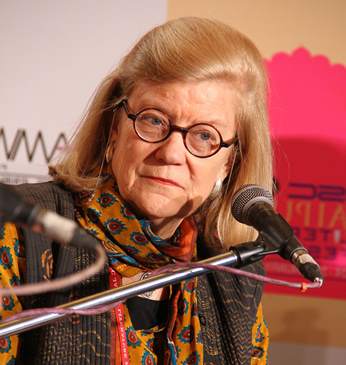Diana Eck is professor of Comparative Religion at Harvard University. Her work includes Banaras: City of Light, A New Religious America and the latest India: A Sacred Geography. She is the founder and director of the Pluralism Project (www.pluralism.org) that studies religious dimensions of America’s new immigration. Eck has received the National Humanities Medal from President Bill Clinton.
Sir James Mallinson is a British Sanskritist specializing in yoga and yogis with several academic books and translations to his name. He has spent nearly a decade living with sadhus in India and is writing a book called Rogue Yogis about his adventures with yoga. From Jaipur he travelled to the Kumbh Mela where he is making a film for the BBC.
What is Kumbh and how is Jaipur Literature Festival related to this great Indian spiritual gathering?
Eck: This festival is a Kumbh of literature, I think, as it preserves the idioms and metaphors of life and faith and helps them translate into the written word. Kumbh Mela is a celebration of faith and cultural memory, of Hinduism, and of arguments, disputes, issues of power, hierarchies, of what continues sacredness and diversity of opinions and views.
Kumbh is also a temporary city. It is a ‘pop-up megacity’, like a bubble universe suddenly coming into existence every twelve years, and then vanishing into thin air. The river bed and the delta of Ganga and Yamuna invite people like me who are interested in religiosity and management, architecture of temporary conurbation housing ten million people for a month and a half. Mapping the Kumbh Mela is a fascinating exercise in logistics and issues like sanitation!
Mallinson: For a yogi like myself, this is a very different time for the sadhus in the mela. In fact, this is the least religious of all times, not just during the main events or the main bathing days, when processions in trucks and jeeps are taken out – I am sure you have seen the pictures – feasts going on in each camp. These times are usually about positioning themselves, like a military cantonment, for the sadhus, who have their sects and sub-sects, often along caste lines. Big battles used to be forged on bathing days, or the most auspicious days for bathing spaces and order. Holy dips had to be calibrated in time, so to say. Well, the sub-sects still have flare-ups, not just on spiritual disputations, but perhaps about power and establishing the order among themselves.
Do you think Kumbh Mela has evolved with time? Or, is it just spiritual exotica?
Eck: As a scholar of religion, this is an incredible experience for me. Living in the camps of the akharas, along with the Hare Krishnas of ISCON, I am compelled to provide a witnessing mission to this unimaginably complex human event. I realize that this study of Kumbh Mela that I am engaged in has many dimensions that go beyond religious studies. Culture like India has developed the technique to manage such a gigantic human event with policing, health and sanitation facilities, food and performances. It’s staggering a feat, to say the least.
Mallinson: Even Kabir-panthis have a camp at Kumbh, who are engaging with people, to make their points. See, this is a venue to opine, because basically, Hinduism is without a central dogma and Kumbh becomes this setting to evolve the boundaries and expand the horizons of the religion. So, it’s of course not just about exoticism, though television channels and faith photographers capture the naga sadhus who clothed only in ash! That’s not all, it’s about poltical power and rewriting its boundaries. Why else would you have your politicians from Bharatiya Janata Party and Vishwa Hindu Parishad taking spectacular dips in the river? Religion is a continuous process and Kumbh is no exception.
